Japan
Wood Products Prices
Dollar Exchange Rates of 25th
Jul
2024
Japan Yen 161.70
Reports From Japan
Tapping vitality of the ASEAN market
The government has announced that specialised staff at
diplomatic missions will be charged with of supporting
Japanese companies engaged in business in Asia.
Dedicated offices will be established in Singapore,
Thailand, Indonesia, Vietnam and India.
The Japanese Foreign Minister said at a news conference
that it is essential for Japan's economy to take in the
vitality of the ASEAN market by backing up Japanese
businesses playing a role of expediting regional trade
growth in the designated countries.
See: https://mainichi.jp/english/articles/20240723/p2g/00m/0na/065000c
Japan and Pacific island agree host of new initiatives
In mid-July the Tenth Pacific Islands Leaders Meeting
(PALM10) was held under the co-chairmanship of the
Prime Minister of Japan and Hon. Mr. Mark Brown, Prime
Minister of the Cook Islands with the participation of
leaders and representatives from 19 countries and regions
including Japan, 14 Pacific Island countries, New
Caledonia, French Polynesia, Australia and New Zealand
along with the Secretary General of the Pacific Islands
Forum (PIF).
Japan and Pacific island countries agreed on a host of new
initiatives designed to boost economic and security
cooperation. The participants agreed on an action plan that
will see Japan boost engagement in seven fields, including
technology and connectivity, climate change, people-
centered development and security.
See:
https://www.mofa.go.jp/a_o/ocn/pageite_000001_00481.html
and
https://www.mofa.go.jp/mofaj/files/100214244.pdf
SMEs hit hard by challenging business conditions
The number of bankruptcies in Japan, especially amongst
the SMEs, has risen so far this year as companies are hit
by soaring costs, labour shortages, the end of pandemic-
related financial support and fewopportunity to raise
prices. In the first half of 2024 the number of companies
filing for bankruptcy rose 22% year-on-year to 4,887, the
highest since 2014. At this rate Japan could see 10,000
bankruptcies by year end.
See:https://www.japantimes.co.jp/business/2024/07/18/economy
/japan-bankruptcies-
rising/?utm_source=pianodnu&utm_medium=email&utm_camp
aign=72&tpcc=dnu&pnespid=_ujngodu56nf8lwgv0c8oviy9a8pp
crogqaqt08subgvuj4jictxindr7zrncae3xd24pq
Real incomes to rise when yen strengthens
Inflation rose for the second straight month in June pushed
higher by rising electricity costs staying above the 2%
target adopted by the Bank of Japan. The consumer price
index, which excludes fresh food, rose 2.6% from a year
earlier following a rise of 2.5% in May.
The increase in inflation is partly due to the ending of
government subsidies for electricity and gas. It has been
reported that June utility bills rose 13%, while
nonperishable food prices climbed almost 3%.
The Japan Research Institute has suggested incomes in
Japan are likely to rise once again in inflation-adjusted
terms if the yen continues to strengthen bringing to an end
the continual and demoralising decline in real pay.
The Institute anticipates real wage growth turning positive
in the July-September quarter assuming yen 155 to the
dollar.
The real rise in wages is expected to continue in the
October-December quarter if the yen hits 151 and into the
January-March quarter next year if the yen goes to 148.
See: https://asia.nikkei.com/Economy/Inflation/Japan-s-inflation-
rate-rose-for-second-consecutive-month-in-June
and
https://asia.nikkei.com/Economy/Japan-forecasts-income-
growth-to-outstrip-inflation-in-fiscal-2024
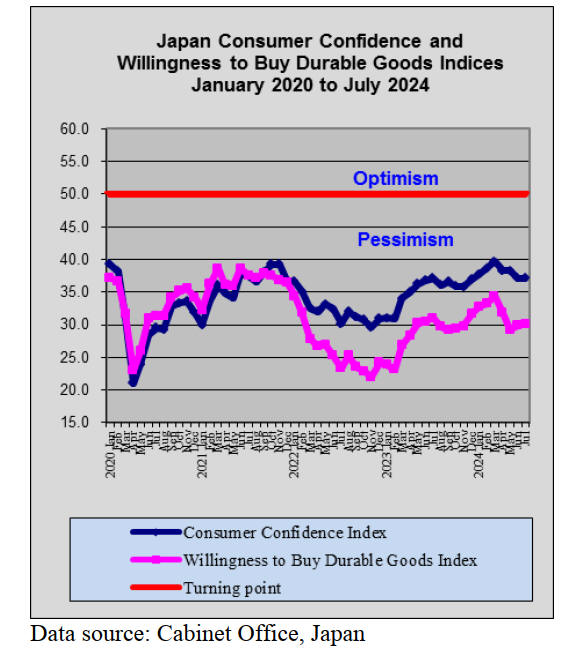
Yen strengthens
The Bank of Japan (BoJ) has raised its policy interest rate
to around 0.25% and decided to slow the pace of its
government bond buying to 3 trillion yen (US$20 billion)
in a further shift toward policy normalisation. The July
was the first major change in policy since the March. The
yen jumped to the 150 level against the U.S. dollar after
the BOJ decision following hawkish remarks by the BoJ
governor who said” an additional interest rate hike may be
possible”.
See: https://mainichi.jp/english/articles/20240731/p2g/00m/0bu/032000c
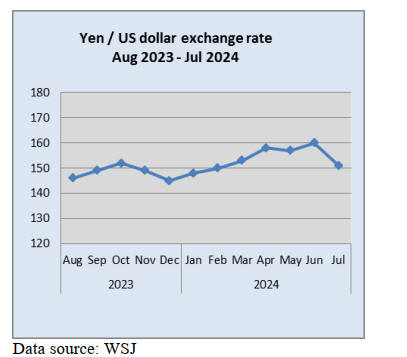
Need for dedicated housing for single seniors
A recent analysis of the housing sector has said there is an
urgent need to secure housing that will allow elderly
people in Japan to live without worry even if they live
alone.
It is estimated that around 20% of households in Japan
will consist of single senior citizens by 2050. It has been
reported that the rate of home ownership is decreasing
among those in their 50s and younger which will result in
higher numbers of elderly people in need of rental housing
which could result in a problem as it is difficultfor such
people to find a rental home as landlords are worried about
rent payments and the consequences of unattended deaths.
To address this, the government adopted legislation for a
system provides financial aid to landlords for renovations
of vacant homes and encourages them to rent to seniors
but the support for landlords is not being fully utilised.
See:
https://mainichi.jp/english/articles/20240722/p2a/00m/0op/010000c
Zero-energy homes not truly self-sufficient
A Ministry of Economy, Trade and Industry report
suggests around a third of Japanese homes labelled as
‘zero-energy’ are not truly self-sufficient in power. The
government offers subsidies for ‘zero-energy’ homes but
the gradual relaxation of criteria for subsidies has led to an
increase in homes that do not effectively reduce
greenhouse gas emissions.
The media report that the number of ‘zero-energy’ homes
of questionable efficiency is rising.
To be classified as ‘zero-energy’ homes there must be as
much renewable power generated as consumed and have
good insulation . Households currently account for 15% of
the country's greenhouse gas emissions.
See: https://asia.nikkei.com/Spotlight/Datawatch/Over-30-of-
Japan-s-zero-energy-homes-fall-short-of-requirements
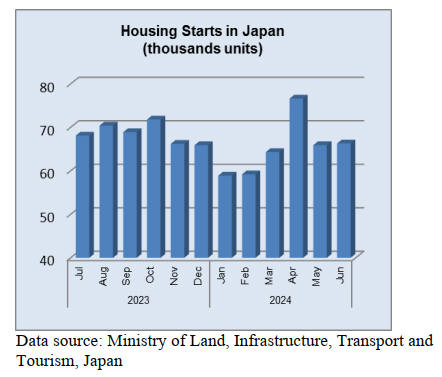
Import update
Assembled wooden flooring imports
May marked the second consecutive decline in the value
of assembled wooden flooring (HS441871-79) imports.
There was a 28% month on month decline in April
followed by a further 10% drop in May.
However, year on year May 2024 imports were at around
the same level as in May2023. Given the pace at which the
yen has depreciated over the past 12 months the overall
area (sq.m) of imports must have fallen.

In May the main category of assembled flooring imports
was HS441875, accounting for 68% of the total value of
assembled flooring imports, this was down from the 75%
recorded for April. The second largest category in terms of
value was HS441879 followed by HS 441874.
Shippers in China accounted for almost 70% of Japan’s
imports of assembled wooden flooring in May with
shippers in Vietnam accounting for another 15%.
Plywood imports
Of the various categories of plywood imported, 86% was
HS441231 in May with HS441233 and HS441234 each
accounting for around 5.5% of the balance. The four main
shippers of plywood to Japan; Indonesia, Malaysia,
Vietnam and China consistently account for over 90% of
plywood imports.
Year on year, the volume of May plywood imports
(441210-39) was 109,788 cu.m which was at around the
same level as in May 2023, however, month on month
there was an 11% decline in the volume of imports with
only shippers in Malaysia recording a rise from a month
earlier.
In May there was month on month a decline in the volume
of plywood imports from China, Vietnam and Indonesia
which accounted for the overall decline in May import
volumes.
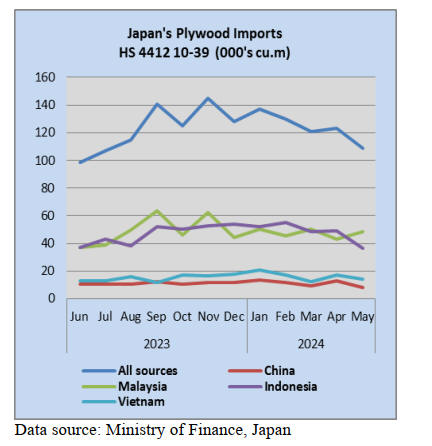
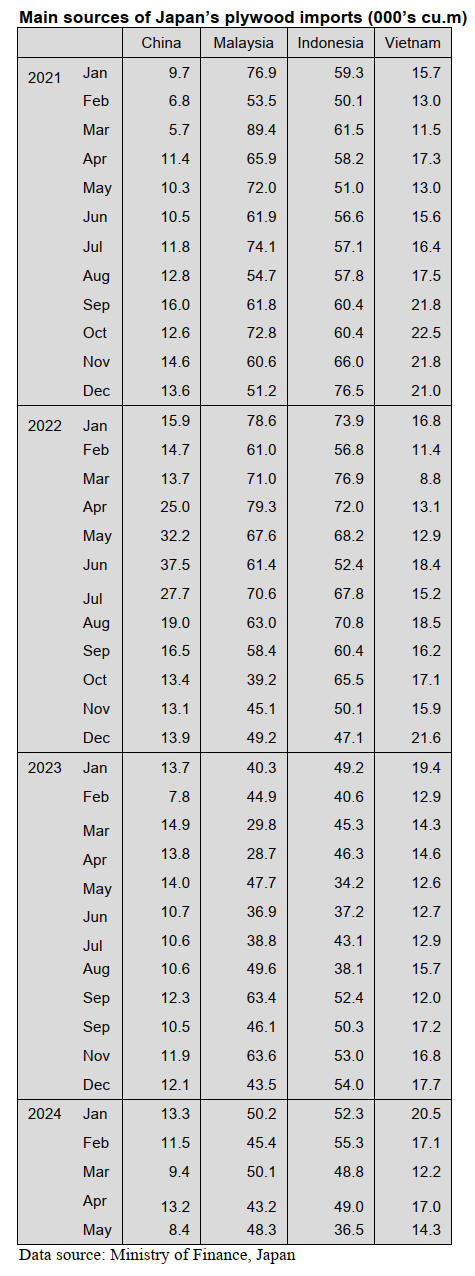
Trade news from the Japan Lumber Reports (JLR)
The Japan Lumber Reports (JLR), a subscription trade
journal published every two weeks in English, is
generously allowing the ITTO Tropical Timber Market
Report to reproduce news on the Japanese market
precisely as it appears in the JLR.
For the JLR report please see: https://jfpj.jp/japan_lumber_reports/
Prototype plywood
Niigata Gohan Shinko Co., Ltd. in Niigata Prefecture has
been developing plywood made of hardwood. The
hardwood will be used on the front and back of the
plywood. This is to use more domestic resources and to
find outif the hardwood would be used instead of South
Sea species.
Niigata Gohan Shinko has been collecting hardwood logs
from Fukushima Prefecture and Nagano Prefecture. Also,
the firm has been purchasing about 100 cbms of hardwood
logs in a month from Iwate Prefecture since February,
2024. The thickness of a hardwood board is 0.8 mm.
Magnolia and pterocarya rhoifolia are very promising for
the front and back of the plywood. Both kinds of
hardwood are very distributed in Japan. The company
makes plywood on an experimental basis by all hardwood
layers, hardwood on the front and back and 4 mm cedar
layer for center of plywood or 12 mm cedar layer.
Nisshin started selling long plywood
Nisshin Co., Ltd. in Tottori Prefecture developed 7.5 mm
long plywood and started to sell the samples to spread the
long plywood. The length of the plywood is 8, 9 and 10
shaku. A shaku is about 30.3 cm.
The company is the only company producing long
structural plywood such as 3 x 10 in Western Japan. The
long plywood is used as bearing walls of a house. The
price of the long plywood rose suddenly when the wood
shock occurred and consumers started purchasing
particleboards or gypsum boards instead of the long
plywood due to the lower cost at that time.
However, there was a fire at one of Nisshin’s product lines
for plywood two years ago and the pant stopped producing
the long plywood. Then, the company restarted producing
the long plywood in June, 2023 but demand for houses
were low so the company struggled with it. Since the
selling price of a house soared due to the high-priced
materials, demand for houses decreased. Housing
companies strengthened in reducing the material costs.
To get back market share of the long plywood, Nisshin
reduced the thickness of the long plywood to 7.5 mm from
9mm. Strength of the 7.5 mm plywood is almost same as
the 9 mm plywood. The price of 7.5 mm plywood is 220
yen.
Sekisui House aims to build 20,000 detached houses in U.S.A.
Seisui House Ltd in Osaka Prefecture showed its goal of
supplying 20,000 units of detached house in the U.S.A. in
the fiscal 2031.
The company completed buying a house builder in the
U.S., M.D.C Holdings, Inc, in April, 2024 and will expand
its original construction method with M.D. C’s 2 x 4
construction method. Sekisui aims to increase overseas
sales coming years, so that the overseas ratio will get
higher. The original construction method and 2 x 4
construction method are used for its house brand called
“New 2 x 4 by Sekisui House”. This brand is good at its
high durability in walls, roofs, thermal insulation,
airtightness, energy saving, energy creation and store
energy.
Also, there is another house brand, “life knit design” and
this is Sekisui House’s design concept for interior. Sekisui
House plants to supply 17,000 units of this brand by the
fiscal2031.
The company puts a goal of supplying 3,000 units of
“Shawood” by the fiscal 2031. The company will do
business not only building detached house but also
developing rental unit and developing communities.
Investment for detached house business will be expanded
to 70 % by the fiscal 2031 from 37 % in the fiscal 2023.
The sales of overseas business occupies 16 % of the sales
in Japan in the fiscal 2023. The sales of overseas business
will be expanded to 45 % in the fiscal 2031.
M.D.C aims to have 769 billion yen in sales in December,
2024 and aims to deliver 9,400 units. These plans are more
than December, 2023.
The consolidated financial statement of Sekisui House and
M.D.C will be 512.6 billion yen in sales and will be 1.7
billion yen in operating profit in the fiscal 2024. Sekisui
House revises up the financial forecast in January, 2025
South Sea Logs and Lumber
There are inquires to South Sea and Chinese lumber even
though there are not a certain amount of orders.
Distributors purchase a little bit of South Sea lumber and
Chinese lumber because demand is low.
When the yen appreciated to 155 to the dollar in the
middle of July 2024, distributors purchased laminated
boards and lumber for decks. Demand for truck body has
been rising due to the new rule in distribution business as
of April 2024.
Demand and supply of South Sea logs are balanced after
logs arrived to Japan from Papua New Guinea in March.
‘White Paper on forest and forestry’
The Ministry of Agriculture, Forestry and Fisheries has
released the White Paper on forest and forestry to the
public on its website. The White Paper shows measures of
forest, forestry and wood industry.
The theme of the White Paper is pollen and forest. It tells
the history of afforestation cedar trees after the war and
how the hay fever increased in Japan. There are also
measures for preventing hay fever in the future. For
forestry labor, there are more detailed information about
foreign workers and women workers than usual. It is the
first time for The Ministry of Agriculture, Forestry and
Fisheries to feature hay-fever on the White Paper.
To avoid giving a negative image of cedar trees, it tells us
the cedar tree is Japan’s endemic species and the cedar
trees have been used for structures since long time ago.
Then, the cedar trees became a main tree species to
afforest.
There is a topic for forest environmental tax starting this
fiscal year on the White Paper. Also, the details of revised
Clean Wood Act, digitalization of forestry bases with
strategy, G7 Hiroshima Summit 2023 and the earthquake
in Noto Peninsula are on the White Paper.
About foreign workers, forestry and forest industry have
been decided and added to the specified skilled worker
visa in March, 2024. 205 foreign workers had been hired
at the forestry offices as of October, 2023. It is specified
that development of working environment and working
styles for women and men will make women to be active
in companies.
The Ministry of Agriculture, Forestry and Fisheries
expects that the White Paper would be used widely in
people for understanding and using more timber.
Therefore, the White Paper will be sold as books and will
be seen on the website. The Ministry of Agriculture,
Forestry and Fisheries acknowledges for people to reprint
the details of the White Paper by specifying the source and
also provides the image data.
See: https://www.rinya.maff.go.jp/j/sin_riyou/kafun/hinsyu.html
|